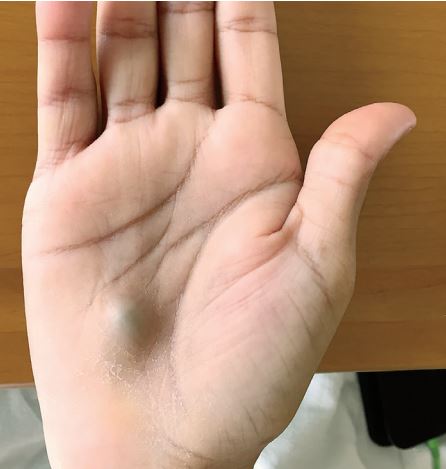This Bulging Lump on a Man's Hand Revealed a Serious Heart Infection

It started out as a red patch on a man's palm. But over the next few weeks, the blemish turned into a raised, blue lump that pulsed with his heartbeat.
The unusual lump turned out to be an aneurysm, or bulging blood vessel, according to a new report of the man's case, published today (March 21) in The New England Journal of Medicine. More alarmingly, the bulge was a sign of a potentially life-threatening heart infection — one that the man may have contracted from a simple trip to the dentist.
When the 27-year-old man went to the emergency room, he told doctors that, in addition to the lump on his hand, he had pain in the upper-left side of his abdomen. He also said that, during the prior six weeks, he'd had fevers, night sweats and little appetite, and he'd lost 26 lbs. (12 kilograms).
An ultrasound of the man's heart revealed that he had an infected mass on his aortic valve — a valve that regulates blood flow from the heart into the body's main artery, called the aorta. Lab tests also revealed that the infection was caused by Streptococcus bacteria, according to the report. [27 Oddest Medical Cases]
Doctors diagnosed the man with bacterial endocarditis, an infection of the inner lining of the heart or heart valves. This happens when bacteria enter the bloodstream and attach to the heart, according to the National Heart, Lung, and Blood Institute (NHLBI). The lump on his hand formed when the infection spread to his blood and damaged the blood vessel.
So how did the bacteria get into the man's bloodstream? His doctors said it's possible that it happened during a recent trip to the dentist. Indeed, activities such as toothbrushing or dental procedures can allow bacteria to enter the bloodstream through the gums, according to the NHLBI. This is more likely to happen if you have poor oral hygiene, which the man had, according to the report.
People are also more likely to develop endocarditis if they have a heart defect, particularly a defect in the heart valves, the NHLBI says. During the heart ultrasound, the man was found to have a condition called a "bicuspid aortic valve," in which the aortic valve has only two flaps, instead of the typical three, according to the Cleveland Clinic. This condition develops in the womb before a person is born and affects about 2 percent of the population, the Cleveland Clinic says.
Get the world’s most fascinating discoveries delivered straight to your inbox.
The man was treated with antibiotics, and his fevers and night sweats went away just two days after he started the medication. He also needed surgery to replace his aortic valve and to repair the aneurysm in his hand, the report said.
Original article on Live Science.

Rachael is a Live Science contributor, and was a former channel editor and senior writer for Live Science between 2010 and 2022. She has a master's degree in journalism from New York University's Science, Health and Environmental Reporting Program. She also holds a B.S. in molecular biology and an M.S. in biology from the University of California, San Diego. Her work has appeared in Scienceline, The Washington Post and Scientific American.

